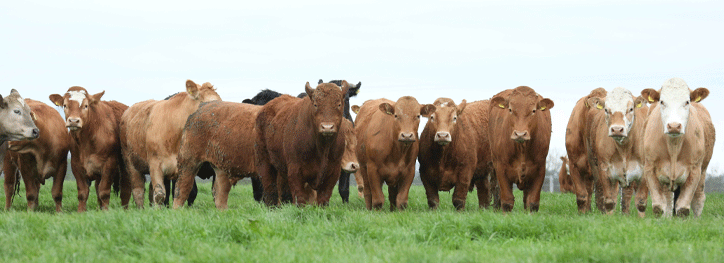Making the most of grazed grass

Beef producers are in the business of converting grass / indoor forages / concentrate into kilograms of carcass as efficiently as possible. Grazed grass is the cheapest feedstuff available to Irish farmers. Better utilisation of grazed grass coupled with strategic use of concentrate supplementation can maximise animal performance, increase output and result in higher margins.
Feed costs account for 75% of variable costs in Irish beef production. Grazed grass is estimated to cost circa €70 per ton of dry matter with grass silage approximately double that. The economic sustainability of beef production systems depends on optimising the contribution of grazed grass to the lifetime intake of feed and using both silage and concentrates as efficiently and strategically as possible.
When cattle are housed for finishing, the cost per kg of live weight gain increases by up to 50% compared to grass-based finishing.
With this in mind, finishing cattle at grass rather than indoors is economically attractive, while reducing/removing the cost of housing accommodation and slurry management.
When considering whether or not to finish cattle at grass a number of factors should be taken into consideration.
- Identify cattle that have the ability to be finished at grass. This decision may be based on gender, breed type and/or animal's present condition.
- Meeting market requirements is critical to obtaining the best price at slaughter. As conformation and appropriate fat cover are critically important to specific markets, ensure animals selected for grass-based finishing can achieve such market requirements.
- Where a number of animals can be slaughtered off grass, and the remainder will be finished indoors, allocate animals into groups according to finishing regimes. While also lowering finishing costs when slaughtering cattle prior to the winter period, benefits of running dual systems on farm include increased cash-flow prior to this expensive winter period.
- Hidden benefit of substitution effects in the latter half of the year, whereby the reduction in consumed herbage can result in an increased stocking rate and consequently increased output per hectare from a fixed land area.
- There is a general trend for beef prices to fall as autumn approaches and feeding at grass helps to beat this rush.
Concentrate supplementation at grass
Key challenges when finishing beef cattle at grass is achieving adequate fat cover on carcasses and maintaining optimum live weight gain, as feed demand on farm increases coupled with declining grass quality as the grazing season progresses.
Recent research has shown that even when good quality grass is in abundance, feeding 0.5 kg/100 kg bodyweight results in greater performance and margin, without negative substitution effects (e.g. 3 kg, 600 kg steer). As we approach the final shoulder of the grazing season, due to autumn grass having a slightly lower nutritive value, coupled with increasing demand on farm due to animals having higher maintenance and intake potential, feeding rates should be increased on the basis of economic return.
Research has shown that feeding 2.5 kg of concentrate at grass will increase carcass gain by 0.30 kg per animal per day. The return on investment is significant at 60%, generated after a 60 day feeding period.
| Cattle supplemented at grass will also have higher kill out percentages (+2%) and higher grades (+0.5) than cattle fed grass only, while aiding in achieving grade and fat score targets required by the Quality Pricing |
The use of a specific concentrate suited to grazing conditions is important to complement a solely grass-based diet. Energy rather than protein is the primary limiting factor in autumn grass and supplementation with concentrated energy sources is required.
GAIN Beef Grass Finisher Nut is based on barley, maize, wheat and soya hulls as the primary ingredients with protein supplied from distillers, beans and rapeseed. Agolin is added for optimum performance, alongside improving the efficiency of energy utilisation, while also reducing the carbon footprint and thereby helping environmental sustainability.
* Achieving success when finishing cattle at grass is highly dependent on good grassland management, with the production and efficient utilisation of high yields of high-nutritive value grass throughout an extended grazing season being essential.*
For more information on GAIN Beef Grass Finisher Nut, please contact your local GAIN Business Manager, branch or visit glanbiaconnect.com
First Published 1 September 2021
